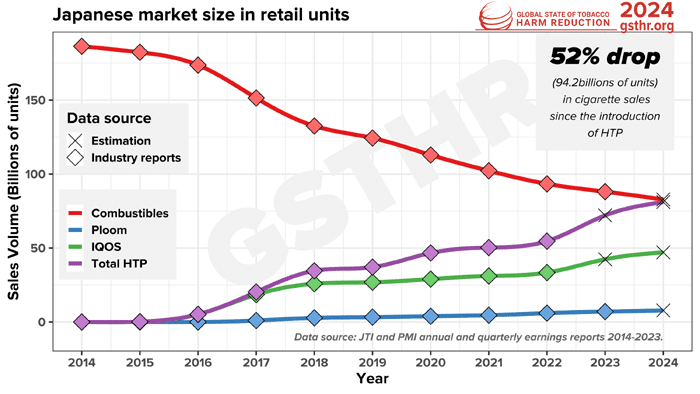 Press release
Press release
MAY 2024
Startling power of tobacco harm reduction as cigarette sales halved in Japan – new GSTHR Briefing Paper
- Cigarette sales in Japan fall 52% in the 10 years since heated tobacco products introduced;
- Transition driven by consumers’ concerns about health, both their own and others’;
- Japan showcases how quickly things can change when those people already consuming nicotine are given access to a safer alternative.
The latest Briefing Paper from the Global State of Tobacco Harm Reduction (GSTHR), a project from UK-based public health agency Knowledge·Action·Change (K·A·C), focuses on the rapid fall in cigarette sales in Japan over the last 10 years following the introduction of heated tobacco products (HTP). “Cigarette sales halved: heated tobacco products and the Japanese experience” explores some of the social and cultural factors that have made Japan particularly suited to HTP and provides an important case study showcasing the potential of tobacco harm reduction through the adoption of safer nicotine products (SNP).
One of a number of positive country profiles set to feature in the fourth biennial Global State of Tobacco Harm Reduction report, published later this year, this Briefing Paper highlights how quickly cigarette sales can fall when consumers have access to safer nicotine products that are acceptable and readily available.
A number of factors made HTP particularly suitable to those people in Japan who smoke combustible cigarettes, which in 2016 was 29.7% of men and 9.7% of women. These included an openness to new technology, but the transition has been overwhelmingly driven by consumers’ concerns about health, whether their own or others’. It should also be noted that part of HTP’s success in Japan arises from a lack of competition from other SNP such as nicotine vapes (e-cigarettes) and nicotine pouches, neither of which can be legally sold in the country.
As well as referencing a number of peer-reviewed science papers, this Briefing Paper, available in 12 languages, also includes some new Global State of Tobacco Harm Reduction research, which compares up-to-date sales figures that emphasise the changing nature of cigarette and HTP consumption.
Using publicly available market data, sales of individual cigarettes were found to be around 182.34 billion units when heated tobacco products started to become more widely available in 2015. By 2023 this had dropped an astonishing 52% to just 88.1 billion units, a fall of 94.2 billion units. Meanwhile, the sale of the tobacco sticks used in HTP that year had risen to 72 billion units in under 10 years.
The story of the reduction in combustible cigarette sales in Japan does not appear to be an entirely straightforward one of substitution, as the Briefing Paper also highlights the prevalence of dual use. Nevertheless, Japan’s changing nicotine market still represents tobacco harm reduction in action, as large numbers of people who smoke are reducing their consumption of cigarettes by sometimes swapping cigarettes for safer products, with all the benefits that brings both to their individual health and wider public health outcomes.
The success of HTP in Japan offers significant hope of their potential to reduce cigarette sales in other similar countries. It should also be noted that this public health success story has happened without significant action or endorsement from the Japanese government. While politicians have allowed HTP to be available, they are mostly treated in a similar way to combustible cigarettes, in terms of where they can be used in public, for example. HTP are subject to lower tax rates than combustible cigarettes, however, and crucially, the producers of heated tobacco products in Japan are permitted to inform consumers that their products are “less harmful” alternatives.
David MacKintosh, a Director of K·A·C, which runs the Global State of Tobacco Harm Reduction project, commented:
“The speed and scale of the change in Japan shows just how quickly things can improve when those people already consuming nicotine are given access to a safer alternative. This is not the result of a specific government policy or initiative, yet the benefits to individuals and society are significant. There are lessons to be learnt from Japan by all those who wish to see the use of combustible tobacco consigned to the history books. Harm reduction is about giving people the opportunity to improve their own health, and the health of those around them. Given the chance most people will do just that.”






